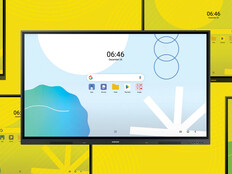Single- and Dual-Arm Monitor Mounts Give Educators Options
The Koncīs family of products includes three models: A single-arm monitor mount and a dual-arm version available in black or magnesium silver.
“The single-arm mount is ideal for any single 15-pound monitor, which today would include monitors as large as 32-inch diagonal, or in some cases even larger,” Albright says.
The single-arm mounts can aid educators in the classroom and are also useful for those teaching from home. The mounted monitor frees up desk space and provides more freedom of movement in a home office environment. This flexibility can increase user comfort and allow movement around a space while still maintaining a connection with students on-screen.
The same is true of the dual-arm products, which can support two monitors with a combined weight of 30 pounds. “They can also be used to support a monitor and a laptop or tablet device,” Albright adds.
With two monitors, a teacher can reference instructional content on one screen while sharing presentation materials on the other. An educator can also use one screen for classroom content while using the other as a webcam connection to students working remotely.
KEEP READING: Create flexible hybrid classrooms with audiovisual tools.
Monitor Mount Features Offer Comfort Without Disrupting Learning
A number of key features differentiate the Koncīs mounts from similar offerings.
Monitor mounts are often clamped to the edge of a desk or attached using a utility grommet, if the desk is properly equipped. While most commercial mounts offer one option or the other, all Koncīs mounts are designed to support both attachment methods.
“In a lot of schools, there may not be the same exact piece of furniture in every classroom,” Albright says. “This gives you the flexibility to adapt to that.”
Legrand’s Koncīs mounts deliver premium-grade features for school districts that want to invest in teacher comfort and productivity. These features include a quick-release interface to simplify the mounting process, along with a cable management system to keep cords tidy while still allowing for full range of motion in the mount arm. A rotation stop helps ensure a mount arm won’t damage a nearby wall with repeated contact. Educators can use the mounts to maintain a sense of organization in their classrooms without disrupting the flow of learning.
“This is about helping make teachers comfortable throughout the school day, giving them the ability to position that monitor for their preferred seeing distance or viewing angle,” Albright says.
In classrooms where ambient light causes glare, flexibility in positioning monitors can help. Teachers who wear bifocals or reading glasses can also use the arms to adjust their screens to meet their needs.
“The flexibility of the monitor really enhances the teacher’s experience, helping them be more productive and improving their wellness over the course of a long school year,” Albright says.
MORE ON EDTECH: K–12 teachers share how they keep students engaged while learning remotely.
SPECIFICATIONS
Chief Koncīs Series DMA1S and DMA1B
Type: Monitor mount
Placing: Desk-mountable
Cable Management: Integrated cable management
Recommended Display Size: Up to 32 inches
Adjustments: Rotation, height, tilt
Tilt: -10 degrees to 65 degrees
Rotation: 180 degrees
Adjustable Height: 20.99 cm to 50.91 cm
Load Weight: 2 to 15 pounds
Chief Koncīs Series DMA2S and DMA2B
Type: Monitor mount
Placing: Desk-mountable
Recommended Use: Two LCD screens
Cable Management: Integrated cable management
Recommended Display Size: Up to 32 inches
Adjustments: Height, tilt, rotation
Tilt: -10 degrees to 65 degrees
Lift: 12.01 inches
Rotation: 180 degrees
Max Load Weight: 4 to 30 pounds
Brought to you by:











